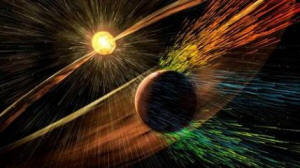|
 Scientists
crack mystery of Mars' missing atmosphere -the sun did it Scientists
crack mystery of Mars' missing atmosphere -the sun did it
 Send a link to a friend
Send a link to a friend
[November 06, 2015]
By Irene Klotz
CAPE CANAVERAL, Fla. (Reuters) -
Scientists have documented a solar storm blasting away Mars’ atmosphere,
an important clue in a long-standing mystery of how a planet that was
once like Earth turned into a cold, dry desert, research published on
Thursday shows.
|
|
 Unlike Earth, Mars does not have a global magnetic field to
protect its atmosphere, leaving it vulnerable to solar ultraviolet
radiation and high-energy blasts of gas and magnetic particles that
stream from the sun during solar storms. Unlike Earth, Mars does not have a global magnetic field to
protect its atmosphere, leaving it vulnerable to solar ultraviolet
radiation and high-energy blasts of gas and magnetic particles that
stream from the sun during solar storms.
On March 8, NASA’s Mars-orbiting MAVEN spacecraft caught such a
storm stripping away the planet’s atmosphere, according to a report
published in this week’s issue of the journal Science.
The so-called "interplanetary coronal mass ejection" caused dramatic
spikes in the number of oxygen and carbon dioxide ions spewing into
space. The March storm was the largest of about a half-dozen similar
events that MAVEN, or the Mars Atmosphere and Volatile Evolution
Mission, has studied since arriving at the planet in September 2014.

The goal of the mission is to study what types of radiation are
coming from the sun and cosmic sources and the impact on gases in
Mars’ upper atmosphere.
The research will help scientists piece together a better
understanding of how Mars evolved from a water-rich, warmer world -
one that NASA’s Curiosity rover mission has shown could have
supported life - into the arid desert that exists today.
The first big-picture look from MAVEN stops short of assessing what
happened to Mars’ water. Scientists say there are two options:
either it escaped into the atmosphere or it is locked in ice beneath
the planet’s surface.
[to top of second column] |

“The single question we’re really trying to get at is, did the Mars
climate change ... by loss to space or by some other process?" said
lead MAVEN researcher Bruce Jakosky, a planetary scientist at the
University of Colorado.
"By quantifying how much gas has been lost to space, we hope to be
able to say whether that has been an important process,” he said.
Ultimately, the research should help scientists pin down a better
window of time when Mars was most suitable for Earth-type life to
evolve.
A trio of related papers in Science, along with 44 reports in the
journal Geophysical Review Letters, shed more light on MAVEN’s
findings, including the discovery that towers of dust are rising
from the planet’s surface into space and that the planet has wide
temperature variations in its atmosphere.
(Reporting by Irene Klotz; Editing by Colleen Jenkins and James
Dalgleish)
[© 2015 Thomson Reuters. All rights
reserved.]
Copyright 2015 Reuters. All rights reserved. This material may not be published,
broadcast, rewritten or redistributed.
 |